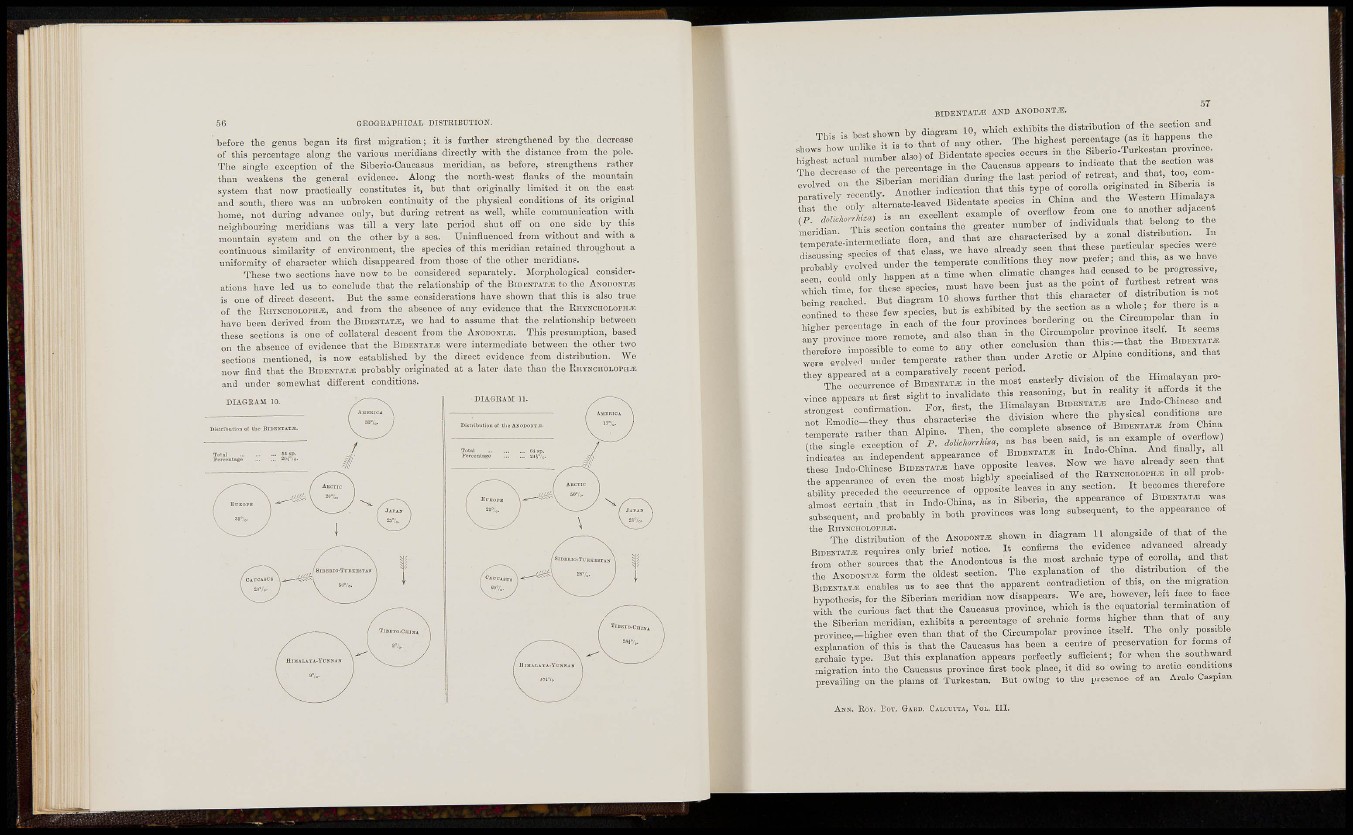
56 GEOGEAPHICAL DISTEIBÜTIOÍT.
before the genus began its fii'st migration; it is further strengthened by the decrease
of this percentage along the vai-ious meridians directly with the distance from the pole.
The single exception of the Siberio-Caucasns meridian, as before, strengthens rather
than weakens the general evidence. Along the north-west flanks of the mountain
system that now practically constitutes it, but that originally limited it on the east
and south, there was an uubrolien continuity of the physical conditions of its original
liome, not dui-ing advance only, but during rotreat as well, while communication with
noighbouriug meridians was till a very late period shut oft on one side by this
mountain system and on the other by a sea. Uninfluenced from without and with a
continuous similarity of environment, the species of this meridian retained throughout a
uniformity of character which disappeared from those of the other meridians.
These two sections have now to be considered separately. Morphological considerations
have led us to conclude that tho relationship of the Bident i m to the Akodohtj!
is one of dircct descent. But the same considerations have shown that this is also true
of the EHYSCHOLOPHa;, and from the absence of any evidence that the Rhvncholoph.'F.
have been derived from the Bidentatje, we had to assume that the relationship between
these sections is one of collateral descent from the Anodonte. This presumption, based
on the absence of evidence that the Bidektat^ were intermediate between the other two
sections mentioned, is now established by the direct evidence from distribution. We
now find that the Bidentat^ probably originated at a later date than the Rhyncholoph.e
and under somewhat different conditions.
BIDBNIAM AMD ANODOSTJS.
d i n ™ m 10 which exhibits the distribution of the section and
This is bes Shown i j « ^ ^ „ happen, the
I t I w B ilt'ate species occurs in the Siberio-Turkostan provruco.
Inghest actual ^ j appe a r s to indicate that the scotron was
The decrease of „f an d that, too, comevolved
on J or i g i n a t e d rn Siberia .s
paratively ^;^^treta;rBidcntate species in China and the Western Il.malaya
that the on J „f „,-e,fl„w fron. one to another adjacent
( P . . , „„ „ b e r of individuals that belong to tho
- i L l ^ e flr an h f L characterised by a temperate-nrte,med>ate flora a ^^^^ ^^^^^ ^^^^ ^ » n a l di s t r ibut ion. ^ ^ ^I n^
" T r e X undt th t m ; , , t e conditions they now prefer; and this, as wo have
probably evolved under ^ ^^^^ ^^^ ^^^^^^ ^^ ^^ progrcss.ve,
seen, could only happen um ^^^^
which time, for rthe r t l ^ f chLeter of distribution is not
T T t t l s c few s i r s , bu is exhibited by tho section as a whole; for there is a
confined to these few ^ a - b ^^^^ circumpolar than m
ana a . rr Bi=
r ^ ^ l T i t ^ r A r c t i c »r Alpme conditions, and that
amy appeared at - J P ^ ^ ^ l ^ t t e C s 'easterly division of the Himalayan pro-
The occurrence .i " • masoning but in reality it affords it the
vinco appears at fl«t ^^ V n t a a a r L E « T A r . are " indo-Chines e and
t h e appearance of even the most highly speciaLisea oi me a
ab l i t f preceded the occurrence of opposite leaves in any section. It bec^omes therefore
a l m l certain that in Indo-China, as in Siberia, the appearance of wa
i c ^ u L , and probably in both provinces was long subsequent, to the appearance of
T r ' T ^ S b X n of the shown in diagram U alongside of that of the
B i d e . ™ requires only brief notice. It conflrms the evidenco advanced already
from other sources that the Anodontous is the most archaic type of corolla, and that
t h e A»odost^ form the oldest section. The explanation of the distribution of tte
B i d e n t a t ^ enables us to see that the apparent contradiction of this, on_the migration
hv-pothesis, tor tho Siberian meridian now disappears. Wo are, however, leit faco to face
with the curious fact that tho Caucasus province, which is the equatorial termmation of
t h e Siberian meridian, exhibits a percentage of archaic forms higher than that of anj
p r o v i n c o . - l u g h e r even than that of the Circumpolar province itself. The only possible
explanation of this is that the Caucasus has been a centre of preservation for forms ot
archaic type. But this explanation appears perfectly sufBcient; for when the southward
migration into the Caucasus province flrst took place, it did so owing to arctic conditions
prevailing on the plains of Turkestan. But owing to the presence of an Aralo-Caspian
As.n-. Eoï. Bot. Gard. Calcutta. Vol. III.